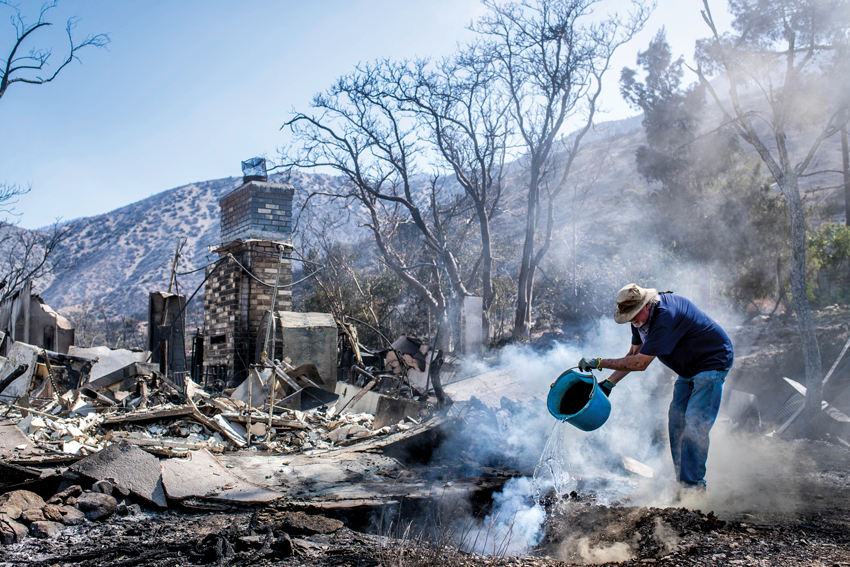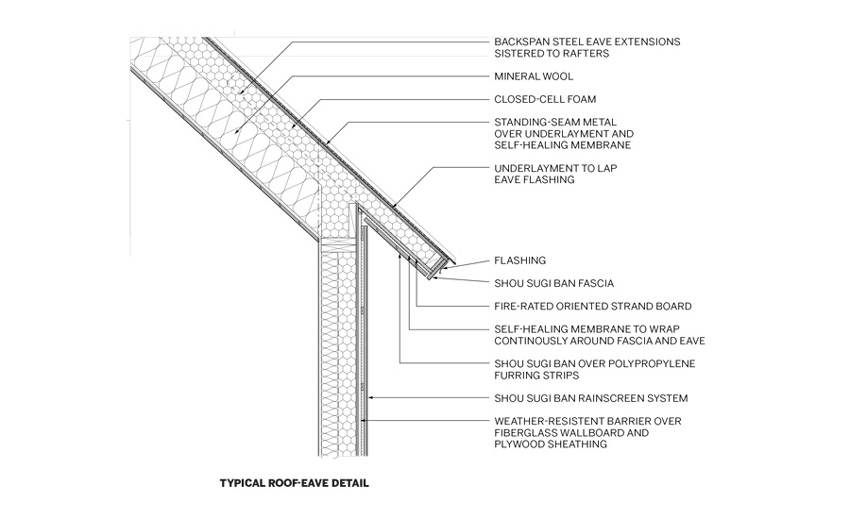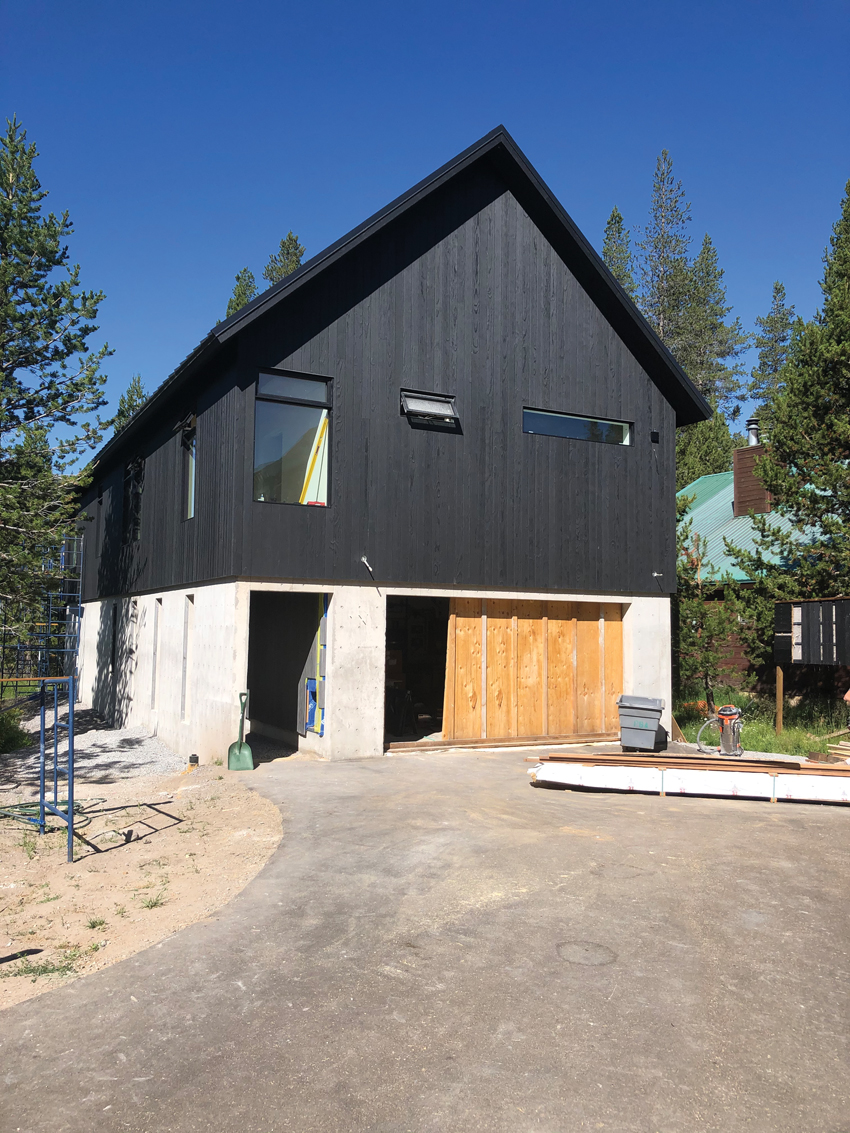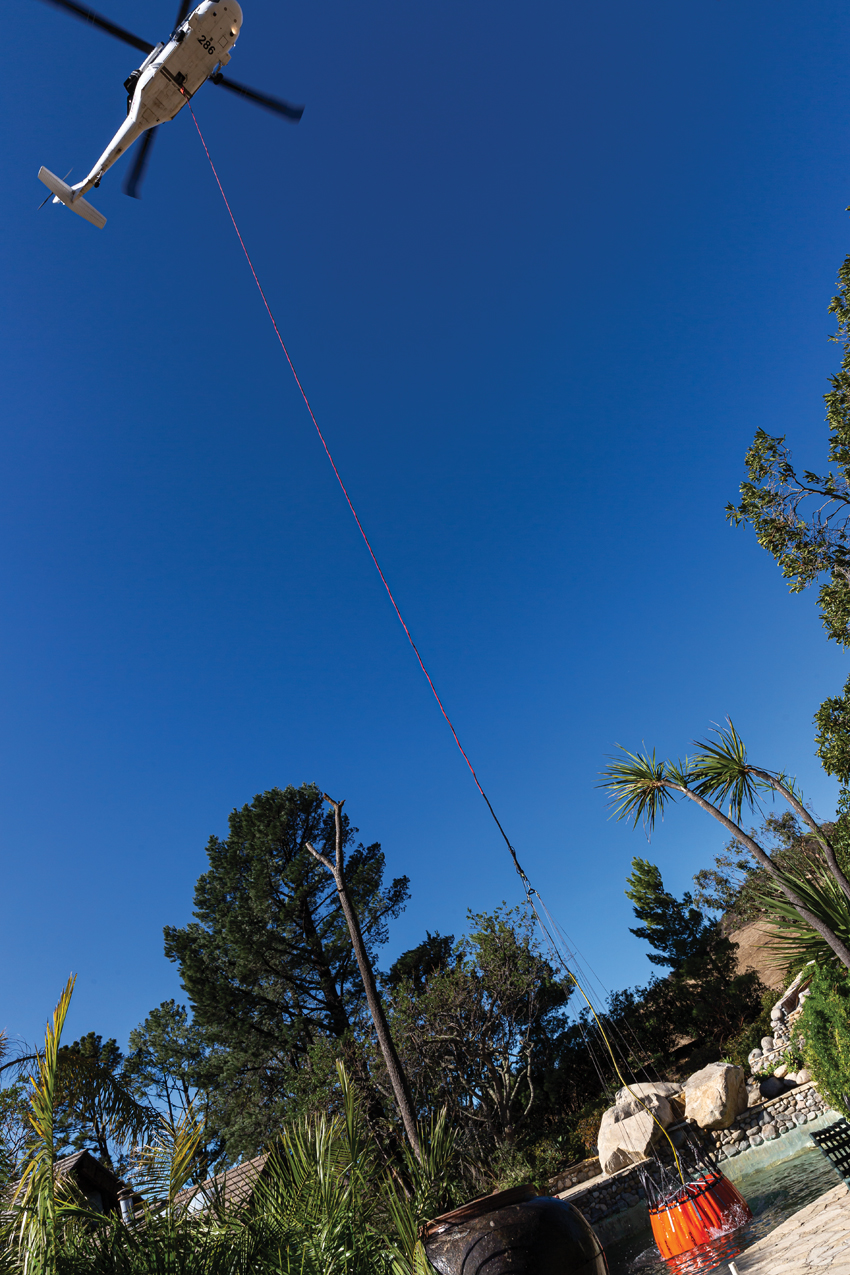This CE Center article is no longer eligible for receiving credits.
View course on architecturalrecord.com »
CALIFORNIA wildfires began shattering existing records early in the current season. By the beginning of October, five of the six largest infernos in the state’s history had occurred, burning through more than 4 million acres—already double the damage in any preceding year. California’s most extensive blaze ever, the August Complex Fire, in the Northern Coastal Ranges, had ripped through more than 1 million acres and was still only partially contained. Megafires had also ravaged large swaths of Oregon, Washington, and other western states. Hardly anomalous anymore, the prior three years had seen their own catastrophic wildfires, with the Camp Fire, of 2018, still holding the devastating record statewide for casualties and structures lost, claiming 85 lives and 18,800 buildings, including destruction of the town of Paradise. Cascading, interrelated factors—among them severe drought; strong dry, hot winds; rising average temperatures; and cumulative forest-management practices—are making such conflagrations increasingly extreme and common. “And when fires extend beyond forest areas into inhabited communities,” says Stephen Quarles, an expert on how building materials and structures fare in such events, “a lot more people open their eyes and take notice.”

PHOTOGRAPHY: © ASSOCIATED PRESS
THE REMAINS of a house in Juniper Hills smoulder after Southern California’s Bobcat Fire in September.
One reason these incidents are crossing more frequently and destructively into the Wildland Urban Interface (WUI), where suburbs and wilderness meet, is the growing migration into those fire-hazard zones. According to U.S. Forest Service data, between 1990 and 2010, the number of homes in the WUI ballooned nationwide by 41 per-
cent, from 30.8 million to 43.4 million—helping fuel the fires. And the trend is continuing, driven by high housing costs in cities and a desire to return to nature.
Meanwhile, built-up greenhouse gases, resulting from human consumption of fossil fuels, have led to increasingly hot, parched conditions in the western United States, with powerful Santa Ana and Diablo winds that fan flames and/or carry embers, sometimes more than a mile, to ignite fires. Intensifying the hazards, overgrown forests have left abundant tinder-dry underbrush and dead trees—some due to bark beetle infestations, but many the casualties of drought—primed for disastrous combustion.
For more than a century, government policies suppressed fire instead of allowing controlled burns to regenerate woodland ecosystems. “Native tribes used that as a land-management tool,” says Chris Dicus, a wildfire authority and professor at California Polytechnic State University. “We stopped doing it—and got too good at putting out small fires, letting forests become extremely dense, which meant dramatically increased water demands, just when drought and heat, brought on by climate change, were diminishing that resource.”
In 2018, California passed legislation to promote managed burning, but change has been slow (and such techniques carry risks, occasionally setting off an uncontrolled conflagration). Meanwhile, the dead-tree overload is daunting: according to a report this September in MIT Technology Review, California needs to reduce fuel levels in 20 million acres of forest—equivalent to the area of South Carolina—to adequately mitigate the wildfire threat.
View course on architecturalrecord.com »
CALIFORNIA wildfires began shattering existing records early in the current season. By the beginning of October, five of the six largest infernos in the state’s history had occurred, burning through more than 4 million acres—already double the damage in any preceding year. California’s most extensive blaze ever, the August Complex Fire, in the Northern Coastal Ranges, had ripped through more than 1 million acres and was still only partially contained. Megafires had also ravaged large swaths of Oregon, Washington, and other western states. Hardly anomalous anymore, the prior three years had seen their own catastrophic wildfires, with the Camp Fire, of 2018, still holding the devastating record statewide for casualties and structures lost, claiming 85 lives and 18,800 buildings, including destruction of the town of Paradise. Cascading, interrelated factors—among them severe drought; strong dry, hot winds; rising average temperatures; and cumulative forest-management practices—are making such conflagrations increasingly extreme and common. “And when fires extend beyond forest areas into inhabited communities,” says Stephen Quarles, an expert on how building materials and structures fare in such events, “a lot more people open their eyes and take notice.”

PHOTOGRAPHY: © ASSOCIATED PRESS
THE REMAINS of a house in Juniper Hills smoulder after Southern California’s Bobcat Fire in September.
One reason these incidents are crossing more frequently and destructively into the Wildland Urban Interface (WUI), where suburbs and wilderness meet, is the growing migration into those fire-hazard zones. According to U.S. Forest Service data, between 1990 and 2010, the number of homes in the WUI ballooned nationwide by 41 per-
cent, from 30.8 million to 43.4 million—helping fuel the fires. And the trend is continuing, driven by high housing costs in cities and a desire to return to nature.
Meanwhile, built-up greenhouse gases, resulting from human consumption of fossil fuels, have led to increasingly hot, parched conditions in the western United States, with powerful Santa Ana and Diablo winds that fan flames and/or carry embers, sometimes more than a mile, to ignite fires. Intensifying the hazards, overgrown forests have left abundant tinder-dry underbrush and dead trees—some due to bark beetle infestations, but many the casualties of drought—primed for disastrous combustion.
For more than a century, government policies suppressed fire instead of allowing controlled burns to regenerate woodland ecosystems. “Native tribes used that as a land-management tool,” says Chris Dicus, a wildfire authority and professor at California Polytechnic State University. “We stopped doing it—and got too good at putting out small fires, letting forests become extremely dense, which meant dramatically increased water demands, just when drought and heat, brought on by climate change, were diminishing that resource.”
In 2018, California passed legislation to promote managed burning, but change has been slow (and such techniques carry risks, occasionally setting off an uncontrolled conflagration). Meanwhile, the dead-tree overload is daunting: according to a report this September in MIT Technology Review, California needs to reduce fuel levels in 20 million acres of forest—equivalent to the area of South Carolina—to adequately mitigate the wildfire threat.
Still, valuable measures involving architecture, construction, landscaping, zoning, land use, and home maintenance can significantly improve protections and resiliency. In 2008, California enacted building code Chapter 7A, one of the few statewide regulations establishing minimum requirements for exterior materials and construction methods in wildfire-prone areas. Applicable to new construction, this legislation focuses on roofs, vents, exterior walls, windows, and porches, offering a menu of noncombustible, ignition-resistant, heat-mitigating, or ember-shielding solutions in each category. Whereas earlier guidelines targeted, almost exclusively, the hazards of wood-shake roof shingles, “we’ve learned that the most likely scenario isn’t a tsunami wave of flame,” says Dicus, “but ignition sparked by windblown embers, and that affects how buildings and their surroundings need to be hardened.” Another major threat, he adds, is high-temperature radiant heat, generating house-to-house blazes.
To keep smoldering embers, or firebrands, from entering attics and crawl spaces, Chapter 7A specifies noncombustible, maximum 1⁄8-inch-mesh vent screens; it also requires comparable protections for building components including roof gutters (where dry leaves could accumulate) and eave soffits. The roof, a particularly vulnerable building component, must be Class A, the highest rating for fire resistance, clad in such materials as metal, concrete or clay tile, or fiberglass-asphalt shingles. Glazing is another key concern, since radiant heat alone can shatter glass and ignite interior combustibles—and any gaps or openings provide access for embers. So code-compliant windows must have tempered or multipane glass.

PHOTOGRAPHY: © ASSOCIATED PRESS
A BED-AND-BREAKFAST in St. Helena was one of hundreds of structures in the Northern California counties of Napa and Sonoma destroyed by this season’s Glass Fire.
Though extreme fire conditions can sometimes overwhelm code requirements, even in Paradise—where glowing-hot pine needles, like lit matches, rained down on the town—such standards may have been essential for withstanding the Camp Fire. An analysis of property records and California Department of Forestry and Fire Protection (CAL Fire) data by the news organization McClatchy found that, in the path of the Camp Fire, nearly 51 percent of the 350 single-family homes built after 2008, when Chapter 7A took effect, escaped damage, while only 18 percent of the 12,100 houses completed earlier endured the fire. Preliminary findings in an ongoing post-fire assessment by Quarles with Yana Valachovic, a forest advisor for Humboldt and Del Norte counties, and colleagues support similar conclusions.
As many experts agree, however, hardening homes against fire must work in tandem with other, equally important, measures: most critically, defensible space. The term refers to a zone immediately around a building, maintained to minimize potentially ember-igniting fuel, as well as flame pathways, by reducing or eliminating vegetation and other combustibles. It also attempts to carve out safe access for firefighters and equipment. California law requires defensible space for most fire-prone areas, with longtime guidelines imposing the most stringent restrictions on Zone 1, the first 30 feet surrounding any structure, and slightly less severe requirements on Zone 2, the band 30 to 100 feet out—but a bill, recently signed into law, adds Zone 0, the first 5 feet, a crucial area for ember-to-house ignition. While the specifics are still in progress, Zone 0 will probably have a prohibition against such combustibles as trees, overarching branches, planting beds, wood mulch, log piles, and flammable fences or trellises. Regulations for the two outer zones include minimum tree spacing (to avoid a continuous canopy) and removal of lower branches (to mitigate ladder fuels).
Planning is also important. Greater distances between structures can reduce house-to-house conflagration, and siting below a hill’s crest, instead of at its peak, can be consequential, as fire tends to race to the top of steep slopes.
But for individual buildings, the existing codes “need to go further,” says Valachovic. She points out that Chapter 7A, for instance, “provides little guidance for post-construction maintenance and doesn’t take a systems approach, integrating the treatment of buildings and their surroundings.” Radiant-heat issues also need more specific attention, she says, since “with homes close together, deployable metal shutters over tempered glass, for example, become more important.”
And Chapter 7A doesn’t deal with the immense challenge of retrofitting pre-2008 construction. While state programs have long provided funding for earthquake-defensive home upgrades, wildfire protections have not received comparable treatment. Local jurisdictions have sometimes offered financial incentives and assistance, but resources are scant. To address such needs, California bill AB-38 passed in 2019, but once Covid overwhelmed the state budget, the funding was cut.
Even for new construction, some communities—including ones previously decimated by wildfire—have bypassed statewide code when it’s recommended but not mandatory. Santa Rosa’s Coffey Park neighborhood, for example, was ravaged by the Tubbs Fire, of 2017, but, before rebuilding, opted out of Chapter 7A, which is discretionary for most urban and suburban areas. Such decisions are often swayed by political pressure to get people back into their houses as quickly as possible (code enforcement requires potentially time-consuming design review) and by limited time frames for fire-insurance payouts. Another factor is sometimes the belief that a megafire’s cause was anomalous—at Coffey Park, embers crossed a six-lane freeway in unusually high winds. (Yet firebrands have vaulted other major highways, as in the Tunnel Fire, which tore through Oakland in 1991, and the Woolsey Fire, of 2018, in Los Angeles and Ventura counties; and in the 2018 Carr Fire, embers traversed the Sacramento River.)
Another deterrent to compliance has been the perception of increased construction costs. But a 2018 study by Montana-based Headwaters Economics, an independent, nonprofit research group, found “negligible cost differences between a typical home and [one] constructed using wildfire-resistant materials and design features.”
Fire Hazard Severity Zone (FHSZ) designations—rated moderate, high, or very high by CAL Fire—play a key role in determining whether state wildfire codes are compulsory for a given area. Dave Sapsis, who is overseeing the current redrawing of CAL Fire’s FHSZ map—a project he anticipates completing before the 2021 wildfire season—says it’s too early to confirm whether it will expand the zones. “But my suspicion,” he admits, “is that some areas will be added that weren’t on the old map” (which dates from 2011). The upcoming version, a two-plus-year effort, deploys more advanced modeling, including sophisticated fire-climate analysis—and, he adds, “since the last one, we’ve been through a lot of very, very big fires—so that’s been a reality check.”


PHOTOGRAPHY: ALEXANDER JERMYN ARCHITECTURE
A SIMPLE, gabled standing-seam metal roof and shou sugi ban siding are among the fire-resistant features of a house nearing completion at the edge of California’s Tahoe National Forest, by Alexander Jermyn Architecture (bottom).
Some municipalities have nonetheless sought loopholes, resisting a hazard-severity rating, probably because of pressure from developers and concern from homeowners that their fire-insurance rates will jump and their property values drop. Yet other communities—after experiencing horrific wildfire directly or in the vicinity—have voluntarily tightened local ordinances. Rancho Santa Fe, in San Diego County, for example, took action following the nearby Cedar Fire, of 2003, developing proactive regulations, many of which exceed today’s state codes (requiring, for example, ember-proof, fire-rated roof vents, instead of fine-mesh screening). The new standards were initially applied to five pilot areas, later put to the test in the 2007 Witch Fire. While 37 older houses, unfortunately, burned, the trial clusters lost no houses. Rancho Santa Fe—now seeking grants for homeowners needing financial assistance with retrofitting—holds its residents to high standards, with scrupulous protection of defensible space. Its rigorous weed-abatement program includes roadside clearance, zone-maintaining guidance for each property, annual inspections, and full-time oversight in the high-growth season (in contrast to the preponderance of municipalities and neighborhoods elsewhere with weak enforcement). “We’re all in this together,” says Rancho Santa Fe deputy fire marshal Conor Lenehan. “It has to be a community effort, on every level.”
And code compliance can dovetail with inventive design. For a soon-to-be-completed house at Lake Serena, an area with a “very high” FHSZ rating, bordering California’s Tahoe National Forest, Berkeley-based Alexander Jermyn Architecture is using Japanese-style shou sugi ban. That dark, beautifully charred timber—here, domestically sourced and Class-A fire-rated—will serve as flame-resistant siding. “The charring burns off the cellulose, the flammable component in wood,” explains firm principal Alexander Jermyn, “but it’s also common sense—think how hard it is to relight logs long after a campfire.” For this lakefront site, prone to heavy snowfall, the house’s ground floor, beneath the shou sugi ban–clad level, was designed to keep out fire and water, with a thick slab on grade, no crawl space, and exterior walls of cast-in-place concrete with few openings. Enhancing these protections, the concrete contains a porosity-minimizing admixture and the densely insulated, fire-rated exterior walls are 8 inches thick. The roof, covered in Class-A standing-seam metal, is a simple single-gable form—eliminating valleys, where complex roofs, or projecting dormers or skylights, might collect dead leaves and embers. “Many of the things that make this house watertight and energy code–compliant,” says Jermyn, “also make it fire-resistant.”

PHOTOGRAPHY: RUSSELL SIMPKINS (LEFT); FUSE ARCHITECTS + BUILDERS (RIGHT)
WEATHERING STEEL and concrete block helped a Fuse Architects + Builders’ bathroom structure remain unscathed when the CZU Lightning Complex fire tore through a sleepaway camp in California’s Santa Cruz Mountains this summer—shown before the blaze (above, left) and after (above, right).
Meanwhile, in the recent CZU Lightning Complex Fire, in the Santa Cruz Mountains—which blazed through 86,509 acres and 1,490 structures—two modest outbuildings at a sleepaway camp survived when all the surrounding construction lay in ashes. With materials including heavy-gauge weathering steel and ground-face concrete masonry, the local firm Fuse Architects + Builders had designed the two communal shower/bathroom buildings for fire resistance and resiliency. The broad underlying concrete pad defines defensible space. With a concrete block-encased core, protecting the water heater, plumbing, solar controls, and batteries from excessive heat and flames, both buildings emerged from the inferno with their lights on and water systems working. The open-sided “floating” roofs (while not suited to enclosed houses) prevented trapped heat buildup. Inside, even toilet-paper rolls remained intact (thanks, in part, to wind conditions that kept embers out).

PHOTOGRAPHY: © CLAY BUSH
FIREFIGHTERS used the swimming pool (visible at lower right of photo) of Malibu, California, architect David Hertz to help contain the nearby Woolsey Fire in 2018.
In Malibu, architect David Hertz—whose Studio of Environmental Architecture includes a think tank/consultancy focused on such climate-change issues as wildfire—has had to defend his own house against conflagration. In the Woolsey Fire, of 2018, his property became the firefighters’ local operations base. “One key to resiliency is redundancy,” he says: “layered systems, backups for the backups.” He also emphasizes the importance of “not bringing fire right to the house” with wood fences or decks that can act as wicks. And he encourages investment in independent on-site water sources (such as cisterns), along with auxiliary (generator- or battery-operated) power supplies, and non-electric pumps or gravity-fed systems to draw water from pools or ponds. In containing the nearby Woolsey blaze, CAL Fire drained his swimming pool, via helicopter buckets, three times.
Certainly, collective wildfire protection among neighbors is essential—as is collaboration among different agencies and disciplines. “The need to develop holistic solutions, with firefighters, architects, builders, landscape designers, policy makers, and fire scientists all working together, has become critical,” observes Dicus. “We’ve been in our own silos way too long.” Hertz goes further, saying, “A call to action is in order—there’s a real urgency. We all need to act, as the adage goes, ‘as if our house is on fire!’ ”
Suplemental Materials
Building a Wildfire Resistant Home: Codes and Cost, Headwaters Economics, Stephen L. Quarles and Kelly Pohl, November 2018. (Through page 11)

















